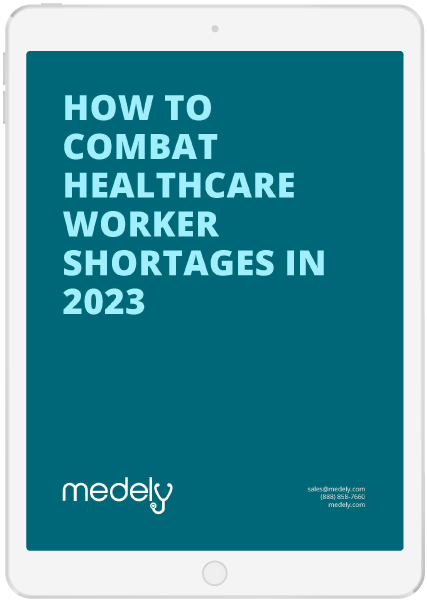Healthcare staffing has always required a flexible and even creative approach. However, as the COVID-19 pandemic rages on, medical care facilities across the U.S. are forced to dig deep to ease healthcare staffing shortages.
While facilities don’t have much room to maneuver, many states create additional space by announcing emergency funding for COVID-19 healthcare spending. So if you’ve been thinking of adjusting your crisis capacity strategies to maintain adequate staffing, this may be an excellent time to try something new.
Healthcare staffing shortages at a crisis level
Healthcare staffing shortages are so significant that the American Nurses Association (ANA) urges the U.S. Department of Health and Human Services (HHS) to declare a national crisis. Many of these issues have been trending for years, but there’s little question that the pandemic has exacerbated them.
- Nurses were already leaving the profession but, as the Delta variant continues to thrive, those numbers are likely to go up; recent surveys show 20-30% of healthcare workers are thinking of exiting over the next few years.
- Human resources struggle with recruitment and retention as competition for practicing nurses increases, and many can’t find the medical professionals they need. Facilities with tighter finances are particularly feeling the pinch.
- There aren’t enough nursing students in the pipeline to bring relief soon. The Bureau of Labor Statistics has already estimated about 194,500 openings for Registered Nurses (RNs) each year, with the most severe shortages predicted for California, Texas, and New Jersey.
Medical care facilities have a front-row seat for every shift and nuance that affects their business and their patients’ direct care. So the question is: What can you do to ease healthcare staffing shortages? One option is on-demand staffing.
On-demand staffing as an alternative to traditional agencies
Karla Williams, Clinical Specialist Manager at Medely, previously led the nursing department at a mid-sized Ambulatory Surgery Center in Arkansas. Her experience there echoed what many healthcare facilities face now: Tight resources that required all hands on deck.
“We had a small pool of professionals that we used,” she shared in an interview for new directors of nursing. “If they weren’t available, I either stepped in to fill that position, or we had to operate shorthanded.”
Karla Williams, Clinical Specialist Manager at Medely,
However, operating shorthanded isn’t ideal for anyone, especially when many medical care facilities are already near capacity. With a budget that didn’t have much room for Travel Nurses and Allied Healthcare Professionals regularly, Williams said she wishes she’d had the option to try on-demand solutions such as Medely as part of her contingency capacity strategies.
“Just having that extra help available would have made a huge difference for the staff,” she said. “Of course, it would have improved safe patient care because staff would have been less tired and rundown. And it would have allowed me to focus more of my attention on my duties instead of bedside care.”
On-demand staffing can connect you with three types of healthcare and allied professionals:
Travel nurses include talent from other parts of the country that can improve your direct care level, add skills you can’t find locally, and close gaps for a while. Competition for travelers is particularly fierce at the moment because their talents are needed in so many parts of the country.
Local assignments use Nurses and Allied Professionals who live in your region but are outside your regular staff—such as someone who’s recently retired and wants to stay involved or a parent whose children recently went back to school full time. One benefit to working with local medical staff is that licensure requirements won’t be a factor.
Per diem jobs include Nurses and others that are available on an as-needed basis when you suddenly find yourself short. One significant benefit is that you can potentially find a match within a few minutes—and easily list them as a favorite for multiple bookings as they grow with your facility.
An on-demand solution means you don’t go through an agency when you have an opening: You can connect directly with Healthcare Professionals when you need them. As a result, a healthcare staffing solution may save you both time and money; Medely customers save as much as 40% without agency overhead.
Other solutions to ease healthcare staffing shortages are on the way
Staffing Industry Analysts (SIA) are predicting a 9% decline in healthcare staffing for 2022.
Esmaeil Porsa, President and CEO of Harris Health System
Esmaeil Porsa, President and CEO of Harris Health System, discussed the extreme issue in front of the Texas Senate committee. “I am faced with a workforce that is tired, overworked and constantly under siege,” Porsa testified. “I have lost staff to fatigue and retirement. I have lost staff to covid infection.” The nursing shortage was declared an ‘internal disaster’ leading to closure of ICU beds, and creating days with zero patients admitted.
And in the longer term, some trends are poised to help reset the balance and reduce burden, such as:
- Reactivating governmental programs from earlier in the pandemic in which state agencies would help hospitals find staff members, with reimbursements from federal coronavirus relief laws.
- Telemedicine services that could improve safe patient care while reducing some requirements for nurses and allied professionals, who may be redeployed to other parts of the system
- Data-driven tools that may improve the impact of recruitment and retention strategies
- Potential opportunities for stronger collaborations around shared supplies and staffing partners
For now, medical facilities need solutions that are flexible, cost-sensitive, and ready-to-go when needed. On-demand job postings, such as staffing with Medely, is an ideal way to improve direct patient care, meet regulatory requirements, and get your facility through to the other side of COVID-19 challenges.

How to effectively combat healthcare labor shortages in 2024
Learn how to effectively combat healthcare labor shortages with an extended workforce to maintain continuity of care and gain access to tools you can use to manage your extended workforce more effectively and efficiently. In this eBook, you’ll learn:
- ■ Why nurses are leaving full-time jobs behind.
- ■ The factors impacting healthcare professional employment.
- ■ How you can use an extended workforce to meet demand.
- ■ How you can use data-led staffing planning to manage costs.



